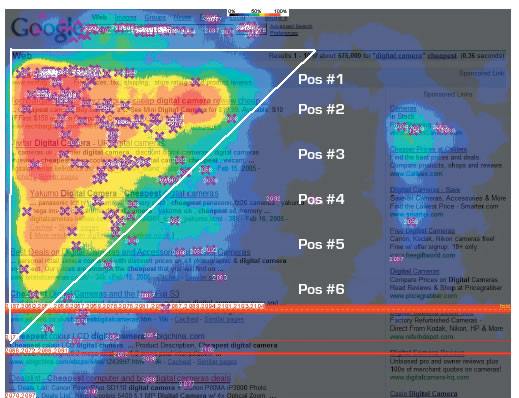Never underestimate the power of SEO and acquiring a top 3 position for multiple keywords in search engines. Since no two consumers think or search alike, the common keyword threads they do use should be anticipated and optimized in order to maximize your websites search engine positioning and corresponding market share.
Enquiro composed an eye tracking study which has become a common staple for SEO (search engine optimization) and SEM (search engine marketing) to convey the power of positioning.
This study reveals “The Golden Triangle” of click throughs from consumers in search engines based on hot spots and the corresponding position of the varied search results.
This is very similar to the terminology of print which refers to this as – “above the fold” which originated in newspaper jargon implying that emphasis of the content above the fold in the paper should be the most prominent to convey relevance.
The term above the fold in online marketing applies to content that appears without having to scroll on your monitor when looking at search results (typically results 1-5) as indicated by the heat map image above.
Consider it impulse, common sense or just plain laziness of the part of the person conducting the search, the fact is, the top 3 results “also known as the golden triangle” are prime real estate for positioning your products or services with the “snippet” to entice readers; a snippet is a summary of the page served up by using the meta-description which works like the c-deck or headline in print to convey impulse or information.
It doesn’t take a genius to figure out that the more keywords a website is optimized for and appears for above the fold, the more potential engagement and conversion it can create.
So, the real challenge for any website is (a) finding the right keywords and (b) finding or creating the right destination for those keywords. It is merely a matter of market intelligence, keyword research and acquiring the keyword and key phrases targeted that best describe your content’s purpose.
The thing about keywords is, once you understand they are the keys to commerce, you can never have too many. It is just about creating continuity and ensuring the page they deliver traffic to delivers with a relevant message to complete the “search and reward cycle” consumers crave and need in order for them to “convert into customers”.
According to Jakob Nielson, one of the worlds’s most quoted information architect and usability expert – “only 17% of readers online actually read your content word for word”. He also implied that readers online quickly skim segments and sections of text in an attempt to glean if they should “invest” their time and attention into the content itself.
This means that your content should be laser like in it’s approach, not sub optimal and communicate the focal point of the page within seconds to entice readers to the preferred conversion objective (to make a purchase, fill out a form, subscribe to an RSS feed, etc).
Combine this with the fact that there are millions of new pages being added to the web daily, the amount of information overload and / or information re-purposing has never reached thresholds as the real-time web, social media mash-ups and RSS feeds stream data on virtually every topic to anyone capable of viewing a popular website or reading a snippet from a site that cloned, copied or restructured the information.
What to Look for with Keyword Research
Just like you wouldn’t start constructing a building without first mapping out the details in advance, keyword research is like the blueprint your website will embody when all of the various stages are complete.
Ideally, you should look for keywords with three primary characteristics. The first is, they should be part of a parent theme (meaning containing the root phrase of the ultimate keyword objective).
The second consideration is it should have high search volume and low competing pages and the third characteristic for consideration is that you must have either adequate content on the topic using the keyword on multiple pages or enough links from other sites to your preferred landing page to acquire a ranking for the keyword in question.
The advantage to using the second condition (targeting longer keyword variations which contain overlapping root keywords) is that any time you optimize mid-tail or long-tail keywords (keywords with 3 or more words that define a phrase) you are gaining traction for all of the keywords contained in that phrase.
Setting the Stage for Keyword Stemming
For example, if we are optimizing a website for the keyword car insurance, then using a stemmed variant of that keyword by adding a keyword modifier such as “affordable car insurance” is still part of that parent theme (as it has two of the words prominent for the main phrase).
You could even take it a step further and GEO target and create landing pages for every state and / or city with that keyword as the root “affordable car insurance Florida, Chicago, Los Angeles, etc.” or use “Affordable Car Insurance in – IL, FL, LA” as additional modifiers.
Although the search volume for each variation may offer less traction than say a more competitive root phrase, less competition for each phrase means that (a) it is far easier to get a top 3 position and (b) the aggregate rankings and traction from multiple phrases ensures a larger footprint for market share.
Even though the main phrase is “insurance” and “car insurance” is more of a market segment, you can gather the gist of keeping overlapping keywords and modifiers aligned for on page and off page positioning.
Even the word “auto insurance” is synonymous with car insurance and other modifiers like “cheap, best price for” and other modifiers such as “rates, pricing or fees” could also be attached to the root phrase “car insurance” to produce a number of unique landing pages and / or keywords for optimization purposes.
After Keyword Research, What’s Next?
After you have selected the most appropriate keywords to frame your offer, you still will have to either (1) mine enough relevance from existing content (2) create or appoint a preferred landing page and (3) get enough internal link equity and enough external inbound links from other sites to deep link to the page you wish to be the prominent search result.
Going back to the premise of targeting keyword with lower thresholds of competition, by devouring the mid-tail and long-tail phrases in a systematic fashion by (a) mapping out where you rank (b) creating enough topical content (c) internally linking the content (d) building enough links to gain traction and (e) taking a new snapshot after things get indexed, you can literally consume a market from the middle to the top or the bottom up using this structured SEO methodology.
The rate in which you consume a market determines on (1) the amount of content, age or authority you site has to begin with (2) the degree of trust search engines allocate to your website and (3) how relevant any given page is for the keyword in question.
Creating Landing Page Continuity
This is where mirroring your theme from keyword research to site architecture is extremely important. For example, there is nothing like creating continuity between the title, url structure, h1 tag and on page internal links to give a page more than enough relevance to rise to the top of rankings.
Brief example:
- Title: Affordable Car Insurance in Arizona
- URL http://www.domain.com/affordable-car-insurance-arizona.html
- H1 tag – Affordable Car Insurance (AZ)
- Internal links (link to page with preferred keywords, same as title).
- External inbound links from other sites link to page with keyword
variations based on preferred ranking (AZ car insurance, affordable car insurance Arizona, etc).
As a result, you give search engines and human readers the most appropriate landing page with enough on page and off page signals to satisfy the appropriate relevance score for that query. If you then in the footer had links to the other states or used secondary navigation to link to IL, LA, AB, and the other 50 states with the keyword Car Insurance attached, then you would essentially be creating your own best link to catapult those pages up the rankings as well.
In this way, the way you optimize your topical content and site architecture both reinforce the metrics necessary to topple relevant keywords and key phrases starting at the branches and working your way in, until eventually as a result of enough content, trust and links the site ranks for the primary phrase in this example which was – “car insurance”.
Now the only difference between this and any other keyword is just that, you have to replace the landing pages, internal links and inbound external links with each of the respective keywords you are targeting, but this was just to provide a basic overview of the SEO strategy involved.
In closing, we leave you with…
Suggested Reading from the SEO Design Solutions Blog:
- SEO and Competitive Keyword Thresholds
- Keyword Research: SEO Traffic and Conversion
- Topical Relevance, SEO and Keyword Stemming
- Keywords and Modifiers, How Visitors Find Your Website
- Keyword Selection, Content and SEO









You are Awesome! :)
This blog is the best I’ve ever found for SEO!
I see you rank #10 in the Google SERP for “SEO”, I have a ? I wanted to ask you that deals with you ranking higher in the SERP, how can I send a email to you, the only link leads to a Quote?
It’s about something I havn’t found in your blog post, & I’ve noticed very few sites use this trick, the sites that do are almost always at the top (#1, #2 SERP).
Thanks, & keep up with the great blog post! :)
Hey SlimJim:
You can reach me at [email protected] and glad you noticed the top 10 for SEO in Google and Bing…
Took a lot of hard work, but we believe in practicing what we preach.
Looking forward to hearing from you.
Jeffery,
Email sent from Jerry. :)
Thanks,
Hello
This is a great post about key words research and search engine positioning.You have explained it step by step so it easy to learn about it.Thank you very much for providing this information.
Thank you for the interesting and informative post. There is a great amount of useful information.
I do really like your supreme outcome! Could you accomplish the term paper essays for example? Because I know that a good classification essay service can create well researched research papers of superior quality.
That eye tracking study tracking graph is amazing. I’m surprised that people have been so conditioned to ignore the Google ads. Thanks for the insight!